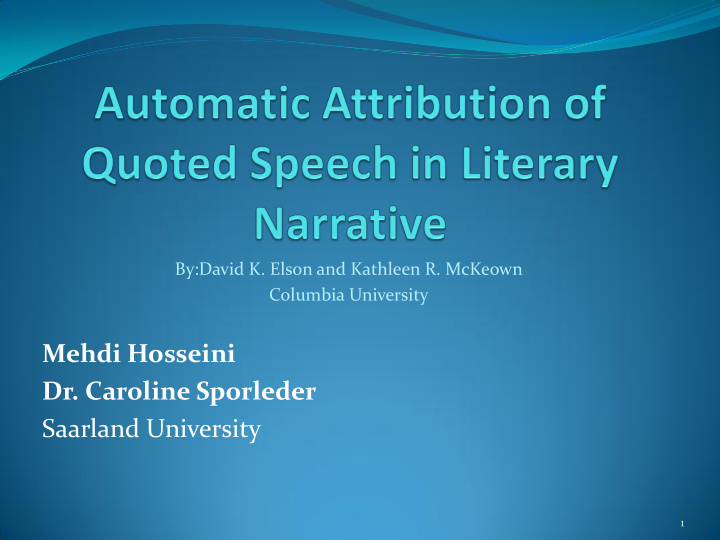



By:David K. Elson and Kathleen R. McKeown Columbia University Mehdi Hosseini Dr. Caroline Sporleder Saarland University 1
Abstract Quoted speech: a block of text within a paragraph falling between quotation marks). We will see a method for identifying the speakers of quoted speech in natural-language textual stories 2
1815 - 1899 3
Identifying the characters in each scene The baseline approach: to find named entities near the quote 4
Several named entities near the quote “Take it,” said Emma , smiling, and pushing the paper towards Harriet – “it is for you. Take your own.” 5
Related Work Most Work on the NEWS domain Sarmento and Nunes (2009) Pouliquen et al. (2007) Not favorable for literary narrative, which is less structured than news text in term of attributed quoted speech . 6
Mamede and Chaleira (2004) work with a set Portuguese children’s stories Glass and Bangay (2007): focus on finding the link between the quote, its speech verb and the verb’s agent. 7
Corpus and its annotation Six authors who published in 19th century Four in English, one in French ( translated by Constance Garnett) and one in French (translated by Eleanor Marx Aveling) Four authors contribute novels, two short stories Dickens often wrote in serial form, but A Christmas Carol was published as a single novella 8
111,000 words 3,176 quoted speech instances 9
Methodology The method for quoted speech attribution: Preprocessing 1. Identify all names and nominals appear in the passage of text preceding the quote in question. Classification 2. to classify the quote into one of a set of syntactic categories. Learning 3. to extract a feature vector from the passage and send it to a trained model. 10
Preprocessing: Finding candidate characters First step is to identify the candidate speakers by „chunking“ names ( Mr. Holmes) and nominals (the clerk) Coreferents and proper names link together as the same entity Example: Mr. Sherlock Holmes Mr. Holmes Sherlock Holmes Sherlock Holmes 11
Pronouns won‘t be chunked as character candidates! 9% of quotes are attributed to pronouns Assign gender to as many names and nominals as possible: Gendered titles: Mr. Gendered headwords: nephew First names: Emma 12
Encoding, cleaning, and normalizing Before extracting features for each candidate, the passage is encoded between the candidate and the quote The steps include: Replace the quote and character with symbols 1. Replace verb indicate verbal expression or thought 2. with a single symbol <EXPRESS_VERB> Removing extraneous information 3. Removing paragraphs, sentenses and clauses that have 4. no information to quoted speech attribution 13
Dialogue chains An author often produces a sequence of quotes by the same speaker, but only attribute the first one Example: “Bah!” said Scrooge, “Humbug!” 14
Syntactic categories The quotes and their passgaes are classified to leverage two aspects: Dialogue chains 1. The frequent use of expressions 2. Pattern matching algorithm assigns to each quote one of five syntactic categories: Added Quote 1. Quote Alone 2. Character trigram: Quote-Said-Person : „Bah!“ said Scrooge. 3. Anaphora trigram 4. Back Off 5. 15
Two categories automatically imply a speaker: Added Quote 1. Character Trigram 2. The rest are divided to three datasets: No Apparent Pattern 1. Quote Alone 2. Anaphora Trigram 3. 16
Feature extraction and learning To build the mentioned three predictive models, the feature vector ʄ for each candidate -vector pair is used. That include: o Distance between candidate and quote (in words) o The presence and type of punktuations between the candidate and quote o Ordinal position of candidate from the quote among the characters o Proportion of the recent quotes, were spoken by the candidate o Number of names, quotes, and words in each paragraph o Number of apprearance of the candidate o For each word near the candidate and quote, whether the word is an expression verb, a punctuation mark, or another person o Features of the quote itself: length, position in paragraph, the presence or absence of character names within, ... 17
ʄ mean : The average value of each feature across the set Replace the absolute value for each candidate ( ʄ ) with ʄ - ʄ mean ʄ - ʄ median ʄ - ʄ product ʄ - ʄ max ʄ - ʄ min And sending them to the three learners: J48, Jrip, and a two-class logistic regression model 18
Final Step to reconcile the binary results into a single decision for each quote, using one of the four methods: Label: Ambiguous, Non-dialogue, 1. Missattributions: (Errors): Overattribution, Underattribution Single Probability: threshold 2. Hybrid: like Label, if more than one candidat S.P 3. Combined Probability: like S.P, but probability of 4. each candidate is derived from two or three probabilities provided by the classifier: mean, median, product and maximum 19
Results and discussion High recall of the names and nominals chunker method (97%) 20
High learning results (83% in average) 21
Thanks For Your Attention Any Question? Any Questions? 22
Recommend
More recommend